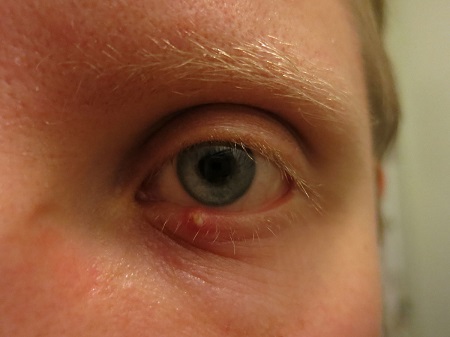Aetiology
A stye (hordeolum) is caused by an acute infectious process involving localised abscess formation at the upper or lower eyelid. One of 3 glands is typically infected: the meibomian glands or the glands of Zeis and Moll (ciliary glands). Staphylococcus aureus and S epidermidis are the most common organisms associated with a hordeolum.[1][2][3][4] This process occurs more commonly in adults than in children, possibly due to anatomical differences. Patients with a chronic illness such as diabetes, blepharitis, seborrhoea, and elevated serum cholesterol may also be at increased risk.[5]
Chalazion formation is more often a chronic process and results from an inflammatory foreign body reaction to sebum. Blockage of normal drainage of sebaceous glands, especially at the eyelid margin, by blepharitis, rosacea, or hordeolum may contribute to development of chalazia.[1][3][4][6]
Pathophysiology
One of 3 glands is typically acutely infected by the staphylococcal species in a hordeolum. Meibomian glands secrete sebum, which helps prevent evaporation of the tear film on the eye; when acutely infected, the hordeolum is termed internal, and is generally less circumscribed in appearance due to its deeper position within the tarsal plate. Zeis and Moll glands (ciliary glands) are generally smaller and more superficial and, when infected, give rise to pain and swelling at the root of the eyelash. These hordeola are termed external and are responsible for the classic appearance of a stye.[2]
Chalazia arise when sebum from meibomian glands is released into the tarsal plate, causing a localised inflammatory reaction. This may occur secondary to mechanical obstruction from a hordeolum or from dysfunction of the meibomian gland with subsequent stasis and release of sebum. As such, chalazia represent a more chronic, non-infectious inflammatory reaction.[1][3][4][6]
Classification
Clinical manifestations
Internal hordeolum
Infection of the meibomian glands; creates moderate, more diffuse swelling; often points towards the tarsal conjunctiva (inside of eyelid).
External hordeolum
Infection of the ciliary glands (Zeis or Moll glands); swelling is smaller and superficial. These typically account for the classic appearance of a stye.
Chalazion
Chronic non-infectious granulomatous inflammation from a foreign body reaction to sebum released from meibomian glands.
[Figure caption and citation for the preceding image starts]: Left upper lid internal hordeolum with limited cellulitisGupta A, Stacey S, Amissah-Arthur KN. Eyelid lumps and lesions. BMJ. 2014;348:g3029. [Citation ends]. [Figure caption and citation for the preceding image starts]: Left lower lid external hordeolumCreative Commons CC0 1.0 Universal Public Domain (https://creativecommons.org/publicdomain/zero/1.0/) [Citation ends].
[Figure caption and citation for the preceding image starts]: Left lower lid external hordeolumCreative Commons CC0 1.0 Universal Public Domain (https://creativecommons.org/publicdomain/zero/1.0/) [Citation ends].
Use of this content is subject to our disclaimer